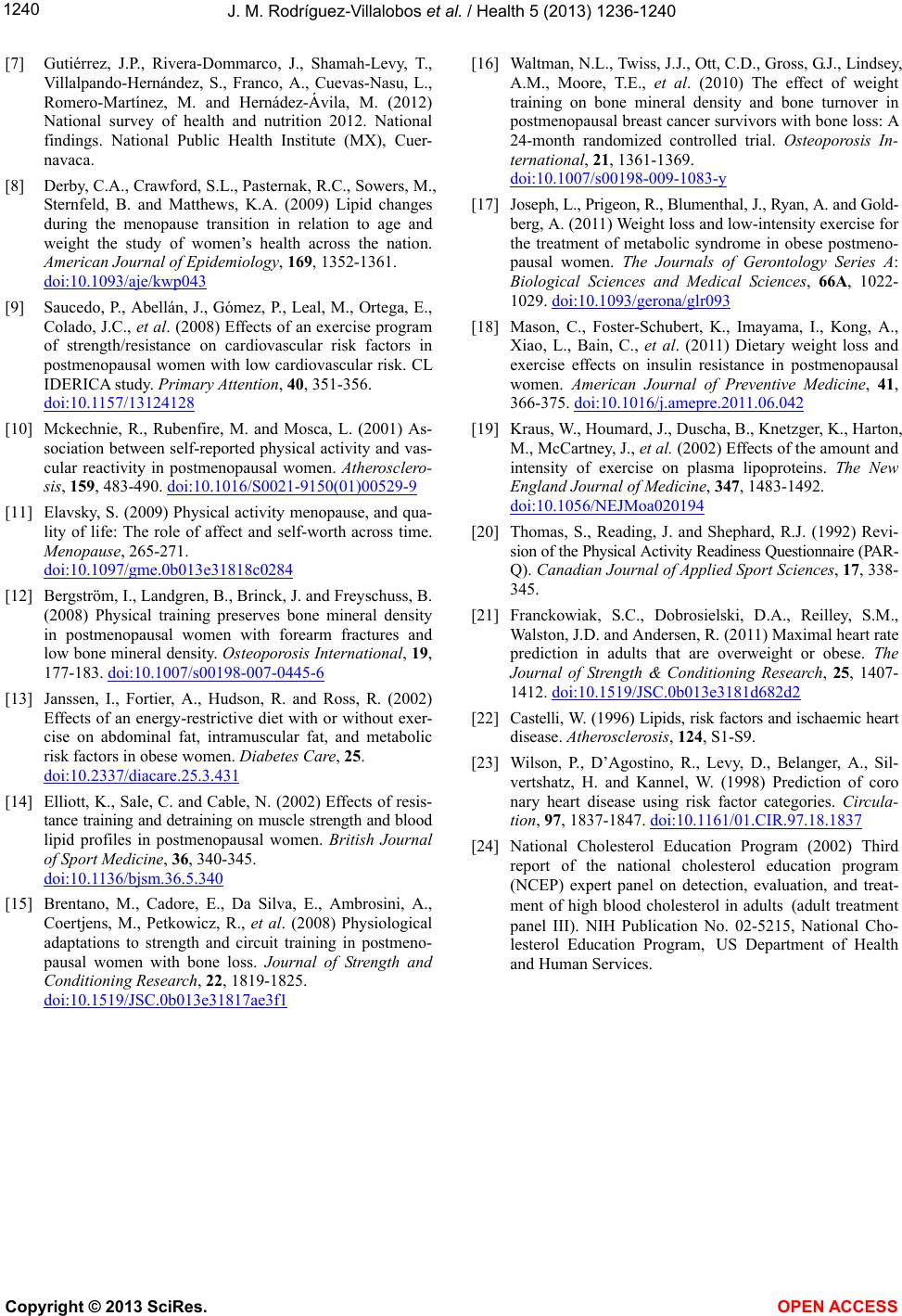
J. M. Rodríguez-Villalobos et al. / Health 5 (2013) 1236-1240
1240
[7] Gutiérrez, J.P., Rivera-Dommarco, J., Shamah-Levy, T.,
Villalpando-Hernández, S., Franco, A., Cuevas-Nasu, L.,
Romero-Martínez, M. and Hernádez-Ávila, M. (2012)
National survey of health and nutrition 2012. National
findings. National Public Health Institute (MX), Cuer-
navaca.
[8] Derby, C.A., Crawford, S.L., Pasternak, R.C., Sowers, M.,
Sternfeld, B. and Matthews, K.A. (2009) Lipid changes
during the menopause transition in relation to age and
weight the study of women’s health across the nation.
American Journal of Epidemiology, 169, 1352-1361.
doi:10.1093/aje/kwp043
[9] Saucedo, P., Abellán, J., Gómez, P., Leal, M., Ortega, E.,
Colado, J.C., et al. (2008) Effects of an exercise program
of strength/resistance on cardiovascular risk factors in
postmenopausal women with low cardiovascular risk. CL
IDERICA study. Primary Attention, 40, 351-356.
doi:10.1157/13124128
[10] Mckechnie, R., Rubenfire, M. and Mosca, L. (2001) As-
sociation between self-reported physical activity and vas-
cular reactivity in postmenopausal women. Atherosclero-
sis, 159, 483-490. doi:10.1016/S0021-9150(01)00529-9
[11] Elavsky, S. (2009) Physical activity menopause, and qua-
lity of life: The role of affect and self-worth across time.
Menopause, 265-271.
doi:10.1097/gme.0b013e31818c0284
[12] Bergström, I., Landgren, B., Brinck, J. and Freyschuss, B.
(2008) Physical training preserves bone mineral density
in postmenopausal women with forearm fractures and
low bone mineral density. Osteoporosis International, 19,
177-183. doi:10.1007/s00198-007-0445-6
[13] Janssen, I., Fortier, A., Hudson, R. and Ross, R. (2002)
Effects of an energy-restrictive diet with or without exer-
cise on abdominal fat, intramuscular fat, and metabolic
risk factors in obese women. Diabetes Care, 25.
doi:10.2337/diacare.25.3.431
[14] Elliott, K., Sale, C. and Cable, N. (2002) Effects of resis-
tance training and detraining on muscle strength and blood
lipid profiles in postmenopausal women. British Journal
of Sport Medicine, 36, 340-345.
doi:10.1136/bjsm.36.5.340
[15] Brentano, M., Cadore, E., Da Silva, E., Ambrosini, A.,
Coertjens, M., Petkowicz, R., et al. (2008) Physiological
adaptations to strength and circuit training in postmeno-
pausal women with bone loss. Journal of Strength and
Conditioning Research, 22, 1819-1825.
doi:10.1519/JSC.0b013e31817ae3f1
[16] Waltman, N.L., Twiss, J.J., Ott, C.D., Gross, G.J., Lindsey,
A.M., Moore, T.E., et al. (2010) The effect of weight
training on bone mineral density and bone turnover in
postmenopausal breast cancer survivors with bone loss: A
24-month randomized controlled trial. Osteoporosis In-
ternational, 21, 1361-1369.
doi:10.1007/s00198-009-1083-y
[17] Joseph, L., Prigeon, R., Blumenthal, J., Ryan, A. and Gold-
berg, A. (2011) Weight loss and low-intensity exercise for
the treatment of metabolic syndrome in obese postmeno-
pausal women. The Journals of Gerontology Series A:
Biological Sciences and Medical Sciences, 66A, 1022-
1029. doi:10.1093/gerona/glr093
[18] Mason, C., Foster-Schubert, K., Imayama, I., Kong, A.,
Xiao, L., Bain, C., et al. (2011) Dietary weight loss and
exercise effects on insulin resistance in postmenopausal
women. American Journal of Preventive Medicine, 41,
366-375. doi:10.1016/j.amepre.2011.06.042
[19] Kraus, W., Houmard, J., Duscha, B., Knetzger, K., Harton,
M., McCartney, J., et al. (2002) Effects of the amount and
intensity of exercise on plasma lipoproteins. The New
England Journal of Medicine, 347, 1483-1492.
doi:10.1056/NEJMoa020194
[20] Thomas, S., Reading, J. and Shephard, R.J. (1992) Revi-
sion of the Physical Activity Readiness Questionnaire (PAR-
Q). Canadian Journal of Applied Sport Sciences, 17, 338-
345.
[21] Franckowiak, S.C., Dobrosielski, D.A., Reilley, S.M.,
Walston, J.D. and Andersen, R. (2011) Maximal heart rate
prediction in adults that are overweight or obese. The
Journal of Strength & Conditioning Research, 25, 1407-
1412. doi:10.1519/JSC.0b013e3181d682d2
[22] Castelli, W. (1996) Lipids, risk factors and ischaemic heart
disease. Atherosclerosis, 124, S1-S9.
[23] Wilson, P., D’Agostino, R., Levy, D., Belanger, A., Sil-
vertshatz, H. and Kannel, W. (1998) Prediction of coro
nary heart disease using risk factor categories. Circula-
tion, 97, 1837-1847. doi:10.1161/01.CIR.97.18.1837
[24] National Cholesterol Education Program (2002) Third
report of the national cholesterol education program
(NCEP) expert panel on detection, evaluation, and treat-
ment of high blood cholesterol in adults
(adult treatment
panel III). NIH Publication No. 02-5215, National Cho-
lesterol Education Program, US Department of Health
and Human Services.
Copyright © 2013 SciRes. OPEN AC CESS